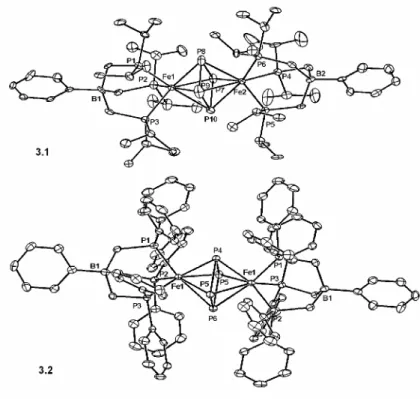I've had the pleasure of working with some fantastic people at The Peters Group over the years. For detailed discussions about the chemistry and for help in collecting the fluorescence data, I would like to thank Brian Leigh.
Introduction and Background to the Coordination Chemistry of Late
Tris(phosphino)borate Ligands
Iron-Nitrogen Multiple Bonds–Imides and Nitrides
Small Molecule Activation
Chapter Summaries
Introduction
Results and Discussion
- Synthesis and Structural Characterization of
- Characterization of [PhBP iPr 3 ]Fe II (H)(η 3 -H 2 SiMeR) by 1 H
- Mechanistic Considerations
Conclusions
Experimental Section
- General Considerations
- DFT Calculations
- Starting Materials and Reagents
- NMR Simulation
- Synthesis of Compounds
- X-ray Experimental Data
P 4 Activation by Iron(I) Affords a Diiron(II) Complex Bridged by a
Introduction
Results and Discussion
Conclusions
Experimental Section
- General Considerations
- Starting Materials and Reagents
- DFT Calculations
- EPR Measurements
- Synthesis of Compounds
- X-ray Experimental Data
Design of Hybrid Bis(phosphino)pyrazolylborate Ligands,
Introduction
Results and Discussion
- Synthesis and Characterization of [PhBP tBu 2 (pz’)]Tl
- Synthesis and Structural Characterization of
- Electrochemistry of [PhBP tBu 2 (pz’)]M(X) Complexes
- Exploring Routes to a Terminal Nitride Complex,
Discussion
- Relative Electron-Releasing Character of [PhBP tBu 2 (pz’)] -
- The Effects of Perturbing the C 3 Symmetry of a Tripodal
Conclusions
Experimental Section
- General Considerations
- Magnetic Measurements
- EPR Measurements
- Electrochemical Measurements
- Starting Materials and Reagents
- Synthesis of Compounds
- X-ray Experimental Data
Synthesis and Characterization of Terminal Iron Imides in the +3
Introduction
In this chapter, it is demonstrated that similar to its tris(phosphine) analogues, the bis(phosphino)pyrazolylborate hybrid ligands are able to stabilize low-valent iron(I) and cobalt(I) complexes as well as high-valent iron(III) ) iron(IV) and cobalt(III)-terminal imides. Despite their prominent role in biological systems,1 examples of coordinatively unsaturated iron(I) complexes such as those described herein are limited.2 Moreover, although implicated as intermediates in group transfer reactions, 3 transition metals in the middle to the late first row (e.g., , Mn, Fe, Co, Ni) with terminal imido/nitrene functionalities are rare. 4 While a number of cobalt imides have recently been reported, 5 iron imide examples are far less common. 6 ,7. The first examples of structurally characterized mononuclear iron imides were those supported by tris(phosphino)borate ligands.7 These species have been reported in the iron(III) and iron(II) oxidation states.
In the iron(III) state, they were obtained via oxidative nitrene transfer from organic azides using low-valent iron(I) precursors. Well-defined FeIV=NR species have generally proved more elusive,8 although thoroughly characterized examples of isolobal FeIV=O species are now well known.9 To our knowledge the single report of a complex that can be formulated as an iron . IV) imide concerns Lee's tetranuclear cluster Fe4(3-NtBu)4(NtBu)Cl3, isolated in only 1-2% yield.10 Mössbauer data for this species were consistent with a cluster with three iron(III) -centers and one iron (IV) center, the latter most likely indicating the terminal FeIV=NtBu moiety.
Results
- Synthesis and Characterization of [PhBP tBu 2 (pz’)]M I (PMe 3 )
- Synthesis and Characterization of [PhBP tBu 2 (pz’)]M III (NR)
- Reactivity of [PhBP tBu 2 (pz)]Co≡N(p-tolyl) and
- Electrochemistry of [PhBP tBu 2 (pz’)]Fe(NR) Complexes
- Synthesis and Characterization of
The EPR spectrum of 5.5 (2-methyltetrahydrofuran, 20 K) shows a rhombic signal similar to that of the related [PhBPR3]FeIII≡NR imide (Figure 5.4).7 The EPR data were simulated at. Nevertheless, structures 5.5 and 5.6 could be isotropically refined to confirm their connectivity and pseudo-tetrahedral geometry. Although this initially suggested an iron(I) monocarbonyl complex, single crystal X-ray diffraction of 5,10 revealed a pentacoordinate dicarbonyl complex (Figure 5.6A).
Due to the thermal instability of 5.12, obtaining a solid state structure was a rather challenging experiment. Nevertheless, the presence of a {B(ArF)4} anion in the solid structure confirmed our assignment of 5.12 as a cationic species. To obtain a better quality data set, we prepared an analog of 5.12 of greater kinetic stability.
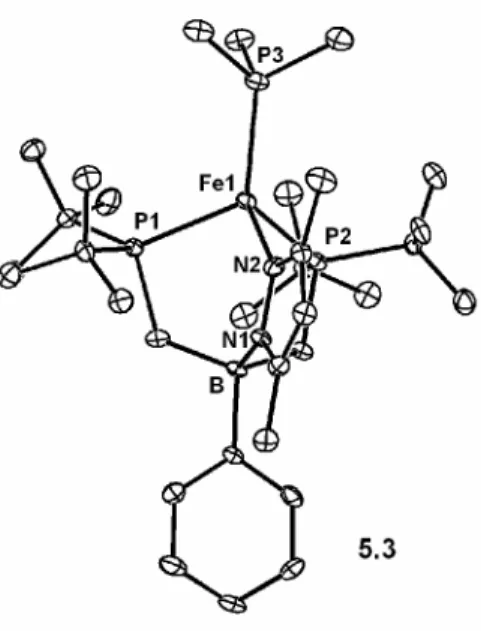
Discussion
Fe-N bond distances for representative iron(II), iron(III), and iron(IV) imide species reported previously or in this paper are compiled in Table 5.1. An estimate of the Fe-N distance in the iron(IV) nitride species [PhBPiPr3]FeIV≡N from preliminary EXAFS data is also presented for comparison. It is noteworthy that in all three oxidation states of iron, the Fe–N distance in the imide complexes differs by only ∼0.02 Å.
This confirms that the Fe-N bond order is maintained and is consistent with the predicted MO diagram for these species. The reason for the increased stability of the FeIV≡NR bond in the [PhBPtBu2(pz')]Fe imides compared to their [PhBPR3]Fe congeners is an interesting problem. This is manifested in the cathodic shift in the FeIV/III potential compared to previous [PhBPR3]Fe-imide systems.
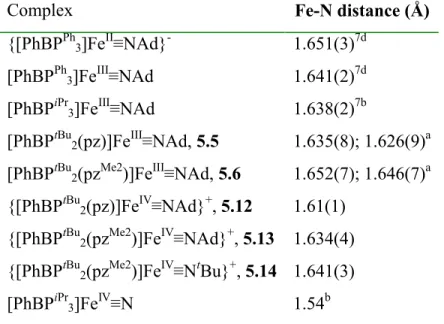
Conclusions
In contrast, the iron(IV) nitride has a significantly shorter Fe-N distance (~1.54 Å), consistent with a higher iron-nitrogen bond order. Based on the increased stability of the iron(IV) complexes upon switching from [PhBPtBu2(pz)] to the more electron-releasing [PhBPtBu2(pzMe2)] ligand, the stability of the iron(IV) oxidation state in this complexes is attributed to a more electron-rich iron center. It is also possible that the lower symmetry of the [PhBPtBu2(pz')] ligand (leading to Cs rather than C3v symmetry) is more compatible with an electronic configuration of a d4 triplet.
Experimental Section
- General Considerations
- EPR Measurements
- Electrochemical Measurements
- Starting Materials and Reagents
- Synthesis of Compounds
- X-ray Experimental Data
The pale green solids were extracted with petroleum ether (5 mL), filtered through Celite, and cooled to -35°C, yielding analytically pure pale green crystals. The remaining pale green solid was extracted with petroleum ether (10 mL), filtered through Celite, and cooled to -35°C, yielding analytically pure pale green crystals. The remaining solids were extracted with cold petroleum ether (2 mL), filtered through Celite, and recrystallized at −35 °C, resulting in spectroscopically pure product as red-brown crystals (0.0450 g, 63.2% ).
The remaining solids were extracted with petroleum ether (4 mL), filtered through Celite, and recrystallized at -35 °C, yielding spectroscopically pure product as reddish-brown crystals (0.0328 g mL) and transferred to a sealed Schlenk tube. The volatiles were removed in vacuo and the remaining red solids were extracted with petroleum ether (8 mL) and filtered through Celite. The volatiles were removed in vacuo and the remaining green solids were extracted with petroleum ether (15 mL) and filtered through Celite.
![Table 5.2. Crystallographic data for [PhBP tBu 2 (pz Me2 )]Fe(PMe 3 ), 5.3;](https://thumb-ap.123doks.com/thumbv2/123dok/10406287.0/148.918.168.804.328.905/table-crystallographic-data-phbp-tbu-me2-fe-pme.webp)
Introduction
Square planar platinum(II) centers supported by nitrogen donor ligands have been more thoroughly studied for alkane activation reactions than phosphine-supported systems. (pyrazolyl)borate (Tp) complexes.6 In this regard, it should be noted that little attention has been focused on group 10 bis(pyrazolyl)borate metal complexes, despite the fact that various platinum studies exploiting Tp ligands represent 2 Tp precursors and/or intermediates. The limited reports on platinum bis(pyrazolyl)borate systems do not describe their utility for C-H activation chemistry.7. Among the more important diimine systems are the (2,2'-bipyrimidyl)platinum(II) complexes reviewed by Periana et al.8 and a number of platinum diimine complexes that have proven particularly useful for precision mechanistic studies.9 Platinum complexes The 2,2'-bipyridine (bpy) ligand and its derivatives have also been extensively investigated, for example in relation to oxidative addition processes. 10,11 There are several reports describing examples of C-H activation reactions mediated by platinum(II) bipyridyl complexes, although these reactions usually involve intramolecular C-H ligand activation processes.12.
In the present study we report on platinum complexes supported by bidentate pyrazolyl and bipyridyl borate ligands. To expand borate incorporation into the ubiquitous bipyridyl ligand class, we synthesized the ligand 2,2'-bipyridyl borate [(4-BPh3)bpy]. This ligand and the bidentate borate [Ph2B(pz)2] comprise the specific ligands of interest herein (Figure A.1).
Results and Discussion
While the [(4-BPh3)bpy] ligand is rigid planar, the [Ph2B(pz)2] ligand is tilted out of the square plane and the pyrazole rings eclipse each other. The formation of significant amounts of both isomers in this reaction suggests that the trans effect of the pyridyl donor with a p-borate unit is quite similar to the unsubstituted donor ring. An estimate of the total kinetic isotope effect for this reaction was obtained by performing the reaction with one equivalent of [HNR3][BPh4] in a 1:1 C6H6/C6D6.
This difference can be attributed to the strong trans influence of the phosphine donors in A.6. This may be due to the greater proximity of the borate unit to the metal center in complex A.4 compared to complexes A.5 and A.6. The destabilization of the Pt(IV) intermediate due to the lack of a third donor chelate arm enables the double process of C-H activation to proceed efficiently.
![Figure A.2: Displacement ellipsoid representations (50%) of two different views of (a) [[Ph 2 B(pz) 2 ]Pt(Me) 2 ][NBu 4 ] (A.4), (b) [[(4- BPh 3 )bpy]Pt(Me) 2 ][NBu 4 ] (A.5), and (c) [[Ph 2 BP 2 ]Pt(Me) 2 ][ASN] (A.6) 3 a,c displaying their geom](https://thumb-ap.123doks.com/thumbv2/123dok/10406287.0/158.918.160.807.403.790/figure-displacement-ellipsoid-representations-different-views-nbu-displaying.webp)
Experimental Section
- General Considerations
- Starting Materials and Reagents
- Synthesis of Compounds
- X-ray Experimental Data
The resulting solids were suspended in toluene (20 mL) and stirred for 5 min, then collected by filtration and washed with hexanes (2 x 20 mL). The resulting solids were collected on a sintered glass frit and washed with petroleum ether (3 x 5 ml) and benzene (3 x 5 ml). The remaining solids were extracted with benzene and filtered through celite to remove [NBu4][BPh4].
The solvent was evaporated in vacuo and the resulting solids were extracted into benzene (2 x 10 mL). The solvent was evaporated in vacuo and the resulting solids were washed with benzene (2 x 10 mL) and dried in vacuo to give a yellow product (~80%). These off-white solids were collected and washed with petroleum ether (3 x 2 mL) and benzene (2 x 2 mL).
![Table A.3. Crystallographic Data for [(Ph 2 B(pz) 2 )Pt(Me) 2 ][NBu 4 ], A.4; [((4- [((4-BPh 3 )bpy)Pt(Me) 2 ][NBu 4 ], A.5; [(Ph 2 B(pz) 2 )Pt(C 6 D 5 ) 2 ][NBu 4 ], A.13; and (Ph 2 B(pz) 2 )Pt(pzH)(CH 2 C 6 H 3 (CH 3 ) 2 ), A.15.](https://thumb-ap.123doks.com/thumbv2/123dok/10406287.0/182.918.153.827.111.635/table-crystallographic-data-ph-nbu-bph-nbu-nbu.webp)
Introduction
Results and Discussion
For example, addition of (TMEDA)LiCH2PPh2 to BPh3 generates [(TMEDA)Li][Ph2PCH2BPh3] (B.1) in good yield. The solid-state structures of the ammonium salts of B.6 and B.8 (Figure B.1) establish the structural integrity of these borates and compare well with structural data for related neutral phosphines (e.g., PPh3 and PhiPr2P ).8 For For comparative purposes, neutral isostructural silane ligands were also prepared (Scheme B.1) via low-temperature arylcarbanion generation (as above) and subsequent quenching with triphenylsilyl chloride. Anionic phosphine salts B.6-B.9 are quite soluble in alcohols (e.g., EtOH), acetonitrile, tetrahydrofuran, chlorinated solvents, and acetone.9 Their stability in CHCl3 and CH2Cl2 is distinct from that of B.1 and the corresponding methylene. -bridged (phosphino) borates, which tend to degrade rather quickly in such solvents.6b Moreover, ligands B.6-B.9 proved to be very stable to both air oxidation and hydrolysis.
Addition of B.9 as a tetra-n-butylammonium salt to {(NBD)RhCl}2 provided the molecular salt {nBu4N}{[Ph3BPp-iPr2]RhCl(NBD)} (B.14), the solid structure of which is shown in Figure B.2. Slow isomerization of B.21 to its thermodynamic trans isomer occurred over a period of days in solution. As a final point of interest, we briefly investigated the ability of B.6-B.9 to promote Suzuki cross-coupling reactions.
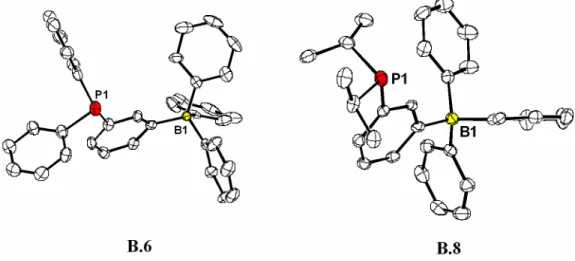
Experimental Section
- General Considerations
- Starting Materials and Reagents
- Synthesis of Compounds
The solution was allowed to warm to room temperature over 2 hours and then filtered through celite in air. The solution was allowed to warm to room temperature over 2 hours and then filtered through celite under air. The solution was allowed to warm to room temperature over 2 hours and then filtered through celite under a nitrogen atmosphere.
The filtrate obtained was dried in vacuo and the remaining solids were extracted with petroleum ether followed by filtration through a plug of silica. The volatiles were then removed in vacuo to afford the spectroscopically pure product as a viscous oil (2.95 g, 60.6. The remaining filtrate was dried in vacuo and the solids were extracted with petroleum ether followed by filtration through a silica plug.
![Figure 1.1 Molecular orbital diagram for [PhBP 3 ]Co complexes. Figure is adapted from reference 12.](https://thumb-ap.123doks.com/thumbv2/123dok/10406287.0/33.918.162.807.382.664/figure-molecular-orbital-diagram-complexes-figure-adapted-reference.webp)
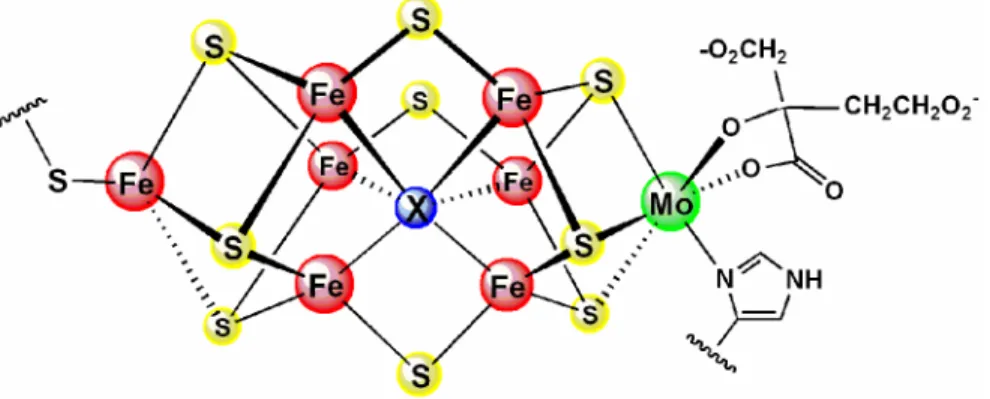
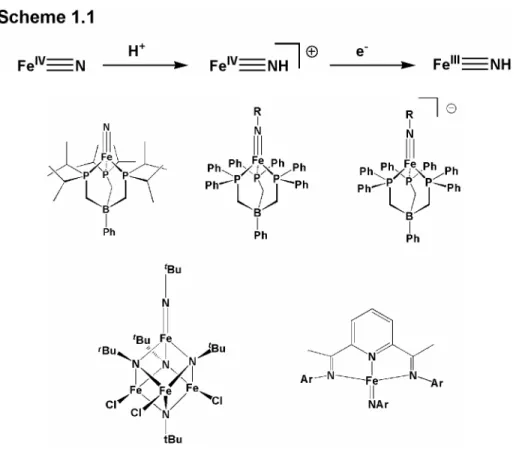
![Figure 2.1. Solid state molecular structure of [PhBP iPr 3 ]Fe II (H)(H 2 SiPhMe) (2.2) and [PhBP iPr 3 ]Fe II (H)(H 2 SiMesMe) (2.3) showing 50% displacement ellipsoids](https://thumb-ap.123doks.com/thumbv2/123dok/10406287.0/48.918.177.754.199.525/figure-molecular-structure-siphme-simesme-showing-displacement-ellipsoids.webp)
![Figure 2.3. Variable temperature 1 H NMR (20˚C to -70˚C, 300 MHz, toluene-d 8 ) of the hydride signal of [PhBP iPr 3 ]Fe(H)( 3 -H 2 SiPhMe) (2.2).](https://thumb-ap.123doks.com/thumbv2/123dok/10406287.0/51.918.267.756.600.902/figure-variable-temperature-toluene-hydride-signal-phbp-siphme.webp)
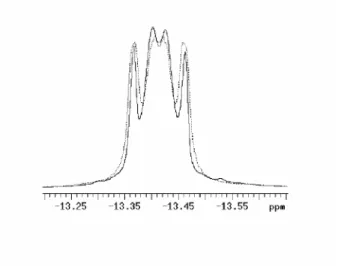
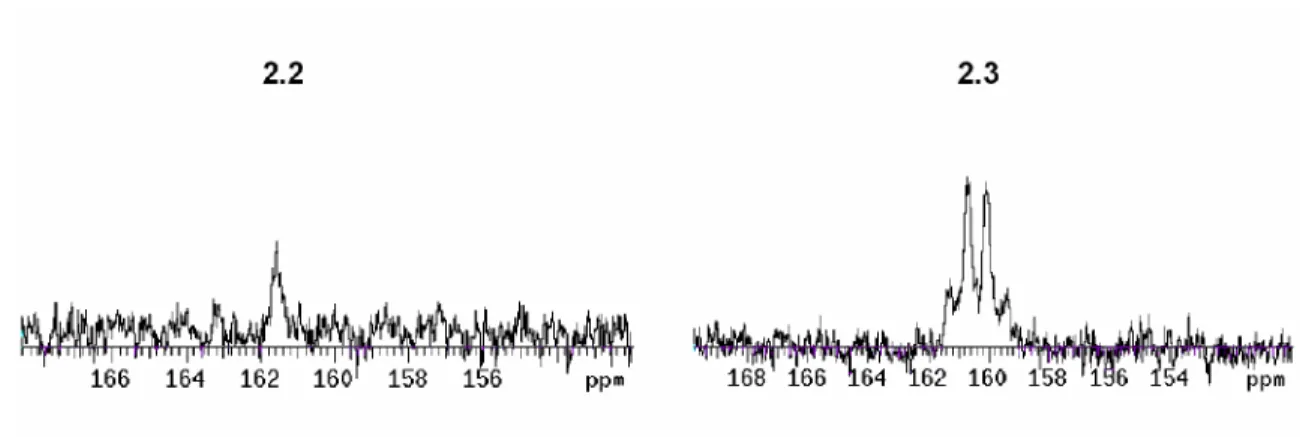
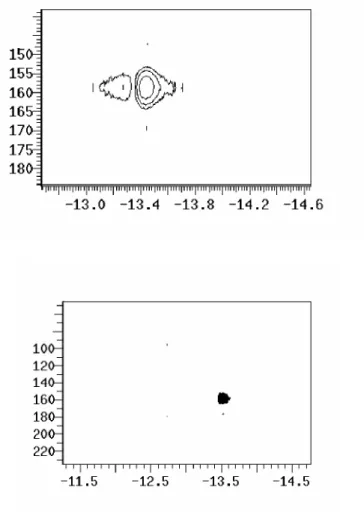
![Figure 2.6 Mössbauer spectra of 2.2, [PhBP iPr 3 ]Fe II (BH 4 ), 19 and [PhBP iPr 3 ]Fe IV (H) 3 (PMe 3 ) 1c at 4.2 K recorded in zero field.](https://thumb-ap.123doks.com/thumbv2/123dok/10406287.0/54.918.215.767.229.1041/figure-mössbauer-spectra-phbp-phbp-pme-recorded-field.webp)
